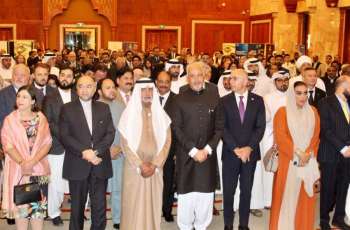A drastic change of power took place in Ukraine five years ago, on February 22, 2014
MOSCOW (Pakistan Point News / Sputnik - 22nd February, 2019) A drastic change of power took place in Ukraine five years ago, on February 22, 2014.
On November 21, 2013, Ukraine suspended the process of signing the EU Association Agreement in order to study the required package of measures in more detail. The Ukrainian cabinet of the day explained this decision by the need to develop economic relations with Russia and other members of the Commonwealth of Independent States (CIS).
The first calls for protest occurred on social media immediately after this decision was announced. On the evening of the same day, about 2,000 people gathered on the Independence Square (called Maidan Nezalezhnosti in Ukrainian) in downtown Kiev.
Initially, protests were fairly calm as several dozen people remained on Kiev's main squares during the night and between several hundred and 2,000 during the day. The situation changed on November 24 when the number of people on Kiev's European Square increased substantially - to approximately 30,000 according to the police and up to 100,000 according to Ukrainian opposition's figures.
During the rally, people set up tents on the European Square and a bit later protesters tried to approach the Ukrainian Government building while its entrance was cordoned off by the Berkut riot police. Protesters started throwing smoke pellets and used tear gas. Law enforcement officers responded with tear gas and took out police batons, although, according to the Ukrainian Ministry of the Interior, the police did not beat up the participants of the rally.
On November 28��29, 2013, the Eastern Partnership summit took place in Vilnius, Lithuania, but the Ukrainian-EU Association Agreement was not signed.
On the night of November 30, Berkut units scattered protesters in downtown Kiev. Total of 35 people were detained during the dispersal. They were released after being charged with administrative offenses. According to medics, 35 people were injured. Western officials denounced the tough actions of the law enforcement authorities.
After the dispersal of the Euromaidan protesters, the emphasis shifted to demands for the government and then-President Viktor Yanukovych to resign.
The Euromaidan protests, that had been ongoing since November, turned into fierce clashes with police against the backdrop of a package of laws toughening the penalty for unauthorized street protests, which the parliament passed on January 16, 2014.
Radical opposition seized local administration offices in a number of regions in western Ukraine. Similar attempts have been also made in Ukraine's central and southern regions.
Reports of the first victims of the unrest emerged on January 22, 2014. The death of two participants in clashes with police has been officially admitted. They were killed by gun shots.
Large-scale street protests resumed in Kiev on February 18, on the day of the Ukrainian Parliament's session, during which the opposition demanded a return to the parliamentary presidential form of government by restoring the 2004 Constitution. The aggressive crowd tried to approach the building of the Verkhovna Rada. Radicals broke into buildings in central Kiev, burned tires and threw stones and Molotov cocktails at the police. According to the police reports, the radicals used firearms for the first time that day.
According to the head of the Department of Special Investigations of Ukrainian Prosecutor General's Office, Serhiy Gorbatyuk, 78 Maidan activists were killed during the clashes on February 18-20, while 278 were injured. Meanwhile, about 50 people died during clashes on Institutskaya Street in downtown Kiev on February 20, 2014.
The investigation identified that gunshot wounds of the dead were caused by automatic weapons. In addition, according to Gorbatyuk, 13 law enforcement officers were killed during the two days of confrontation, 650 of them were injured.
On February 21, 2014, Yanukovych announced his decision to initiate early presidential elections and return to the 2004 Constitution with the redistribution of powers in favor of the parliament. He also urged the nation to start forming a government of national trust.
Later, Yanukovych and representatives of the opposition signed a settlement agreement with European Union mediation.
On February 22, the Verkhovna Rada passed a resolution on the Ukrainian president's "unconstitutional self-withdrawal from performing his constitutional duties" and setting early presidential elections on May 25.
On February 23, the Ukrainian Parliament passed a resolution appointing speaker Oleksandr Turchynov Ukraine's acting president.
On February 27, the Rada endorsed the so-called "government of popular trust" with Arseniy Yatsenyuk as prime minister.
On February 28, Yanukovych said at a news conference in Russian city of Rostov-on-Don that he would never recognize the Rada's decision to remove him from office.
Early presidential elections took place in Ukraine on May 25, 2014. Twenty-one candidates ran for the top government post. Independent candidate and billionaire Petro Poroshenko won the elections with 54.7 percent of votes.
Crimea did not recognize the legitimacy of the new Ukrainian authorities. On March 11, 2014, the region's Supreme Council adopted a declaration supporting independence from Ukraine and expressing its intention to reunite with Russia.
On March 16, a referendum on Crimea's future took place on the peninsula. The majority of the voters (96.77 percent) backed reunification with Russia. Based on the referendum and the declaration in support of independence, the Supreme Council of Crimea passed a resolution on independence from Ukraine on March 17, 2014. On March 18, Crimea signed an agreement reunifying with Russia.
On March 21, Russia adopted a Federal constitutional law on the formation of two new regions - the Republic of Crimea and the federal city of Sevastopol.
A number of regions in the southeast of Ukraine did not recognize the legitimacy of the new Kiev authorities. On May 11, the Donetsk and Luhansk regions, together known colloquially as Donbas, held referendums on their own status. On May 12, the Donetsk and Luhansk people's republics proclaimed themselves sovereign states.
In April 2014, the Ukrainian authorities launched a military operation against the breakaway regions of Donetsk and Luhansk.
In September 2014, a memorandum to end the armed conflict and to proceed to its resolution through diplomatic negotiations was signed in Minsk after the offensive operation, as a result of which the militia took control of a number of large settlements in the Donetsk and Luhansk regions. However, after some time, the military confrontation resumed.
In February 2015, after another successful militia operation, the Minsk Agreements were signed with the direct participation of the leaders of Russia, Germany, France and Ukraine. The idea was to create a political and legal basis for the peaceful resolution of the conflict: to adopt an amnesty law for all parties to the civil conflict, declare the Donetsk and Luhansk regions special territories and enshrine it in the country's constitution, as well as set a date for local government elections.
However, almost all clauses of the Package of Measures for the Implementation of the Minsk Agreements remained unfulfilled.
Exchanges of fire continue between the parties to the conflict. According to the latest UN data, more than 10,000 people have been killed as a result of the conflict, including more than 3,000 civilians.




